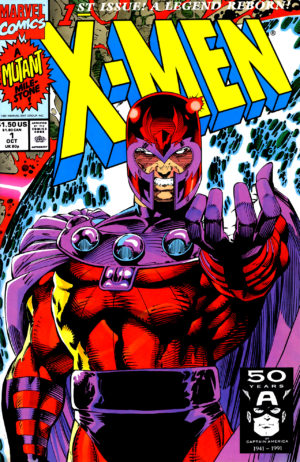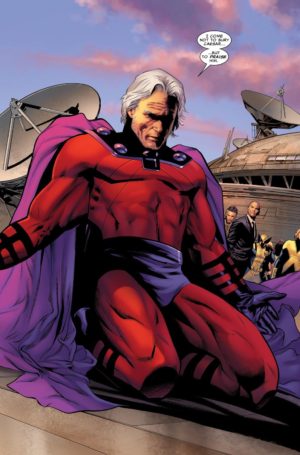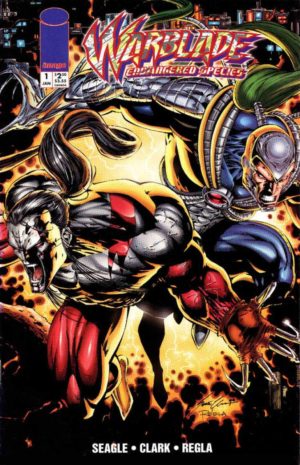[Patreon-Nov16-Post-Bug][/Patreon-Nov16-Post-Bug]Today I get to announce the second villain to join the Crushing Comics pantheon of comic guide pages: Magneto, The Master of Magnetism!
That’s right, night I bring you The Definitive Magneto Collecting Guide and Reading Order. This new guide is available exclusively to CK’s Crushing Comics Club Patrons until January 15th. Want early access? Visit CK on Patreon to learn more.
I’ve long said that of all the Marvel characters who never had their own title (well, until 2014), Magneto’s arc is one of the most consistent and fascinating.
 Stan Lee and Roy Thomas had established the allegory of Xavier’s closed hand approach to leading mutants versus Magneto’s closed fist long before Chris Claremont first penned the character in 1975. Magneto transform from a one-note villain in X-Men #1 in 1963 to a man blinded by the frenzy of needing to defend his own people by either establishing a sovereign nation for them or bending the entire world to his will.
Stan Lee and Roy Thomas had established the allegory of Xavier’s closed hand approach to leading mutants versus Magneto’s closed fist long before Chris Claremont first penned the character in 1975. Magneto transform from a one-note villain in X-Men #1 in 1963 to a man blinded by the frenzy of needing to defend his own people by either establishing a sovereign nation for them or bending the entire world to his will.
Chris Claremont made Magneto’s seemingly Sisyphean struggle resonate more deeply when he began to gradually reveal that Magneto was the survivor of Auschwitz concentration camp in Nazi Germany in a series of references and flashbacks starting in Uncanny X-Men #150 in September of 1981. Suddenly, his fervor over leading mutant-kind was contextualized, though it still could not excuse his acts of violence (as in the same issue, when he drowns an entire Russian submarine full of sailors). His repeated attempts to carve out a sovereign, defensible homeland for mutants were suddenly and tragically recast as a way of recreating Israel prior to the World War II rather than after.
Marvel really loves to say that each of their annual events “will change everything,” but the original Secret Wars did just that for Magneto in 1984. By grouping him with the heroes in the outset of the story, The Beyonder (and, by extension, his author and editor-in-chief Jim Shooter) recognized the layer of nobility that Claremont had so deftly played up in Magneto’s previous appearance.
In turn, that cleared the path for Claremont to begin Magneto’s rehabilitation as soon as he returned from the company’s first line-wide event. He placed Magneto into a sympathetic position, shipwrecked and under the care of Lee Forrester on his own former island base, and then had Xavier personally commission him as the leader of the X-Men in the run-up to Secret Wars II in 1985.
That flawed nobility has never since left the character. Even through several later returns to villainy, Magneto’s focus is never pure evil (or, if in hindsight it seems to be, it’s quickly retconned away). That’s partly due to his relative scarcity through 2010. After “Acts of Vengeance” in 1989-1990, Magneto rarely appeared outside of X-books, and was always promptly mothballed upon his exit – as in his memorable turn in Claremont and Jim Lee’s X-Men, Vol. 2 #1-3 in 1991.
In a March 1999, Alan Davis and Fabian Nicieza finally granted Magneto his wish, with him assuming rule over the island of Genosha off the Southeastern African coast. As with the unending holy war between Palestine and Israel, Magneto’s Genosha was built atop the ruins of a country known not only for discrimination against mutants, but for pressing them into slavery and genetic mutilation.
 It seems that the land is cursed with ill intent, and Magneto couldn’t escape that when a super-sentinel cuts him and his millions of subjects down in cold blood in the shocking opening scenes of Grant Morrison’s New X-Men. Yet, Claremont would find a way to cheat that death (after all, it’s his speciality) in a 2004 iteration of Excalibur, using Magneto as leverage to kick off the House of M event.
It seems that the land is cursed with ill intent, and Magneto couldn’t escape that when a super-sentinel cuts him and his millions of subjects down in cold blood in the shocking opening scenes of Grant Morrison’s New X-Men. Yet, Claremont would find a way to cheat that death (after all, it’s his speciality) in a 2004 iteration of Excalibur, using Magneto as leverage to kick off the House of M event.
The wake of House of M left Magneto without powers or purpose, given than less than 200 mutants remained on the Earth. It was Ed Brubaker and Matt Fraction – hot off their co-authored run on Immortal Iron Fist in 2008 – who set Magneto on a new path that culminated in his becoming one of the anchors of the X-Men books from 2010 to the present day.
Fraction’s run on Uncanny X-Men saw Magneto reclaim his powers and then submit himself to the service of Cyclops, who had been pressed into leading the entire mutant race past its potential extinction due to the events of Messiah Complex.
Kieron Gillen and then Brian Bendis loved the subtext of Magneto’s inability to simply play the right hand man, but it was Cullen Bunn who seized upon it in his unexpectedly riveting Magneto solo series in 2014. There, in the vacuum of positive or negative leadership of the mutant race, Magneto began to silence or subvert elements he found unacceptable all while undermining Cyclops as a revolutionary leader through being a triple-agent with SHIELD.
The arc of Magneto’s ascendence was so strong that after the line-wide reset of Secret Wars, it was Bunn who was tasked with writing the always-popular flagship of Uncanny X-Men – with Magneto at the helm.
That’s a lot of story over the course of over fifty years of Magneto’s publishing life. The Magneto Guide walks you through every issue in reading order, often proving context and major story beats to help orient you to each tale.
That adds up to hundreds of comics from dozens of different titles. What if you’re not interested in all of that, but just in the spine of the story I’ve described in this post? Don’t worry – I’ve got you covered…
[Read more…] about New Collecting Guide: Magneto (plus: a list of his key appearances!)
 Magneto was a sparsely-used villain in the 20 years from his debut in X-Men #1 in 1963 through 1984. He regularly appeared once every year or so in X-Men, plus had a few exploits with the Avengers and his former recruits, Quicksilver and Scarlet Witch.
Magneto was a sparsely-used villain in the 20 years from his debut in X-Men #1 in 1963 through 1984. He regularly appeared once every year or so in X-Men, plus had a few exploits with the Avengers and his former recruits, Quicksilver and Scarlet Witch. No matter what I say about the lumpy scripting on this book, it’s definitely in the upper half of good looking WildStorm ongoings as Stormwatch wobbles through multiple artists and Deathblow switches away from Tim Sale.
No matter what I say about the lumpy scripting on this book, it’s definitely in the upper half of good looking WildStorm ongoings as Stormwatch wobbles through multiple artists and Deathblow switches away from Tim Sale. This run finds Stormwatch disintegrating without Battalion as the glue to hold it together. No one seems especially interested in obeying Synergy unless it suits them, and Diva has only marginally better luck. That lends an extra layer to Timespan’s egging Battalion on to his death – maybe the real goal was to destroy Stormwatch, and the only way to do it was to convince Battalion that he was fated to die?
This run finds Stormwatch disintegrating without Battalion as the glue to hold it together. No one seems especially interested in obeying Synergy unless it suits them, and Diva has only marginally better luck. That lends an extra layer to Timespan’s egging Battalion on to his death – maybe the real goal was to destroy Stormwatch, and the only way to do it was to convince Battalion that he was fated to die? While Grifter eventually getting his own title was fait accompli, at this point it feels like Warblade is the least deserving of all the WildCATs who merited their own sideline series. At least Maul has the dichotomy of being a modern art loving nerd by day and a massive purple hulk on the battlefield. Maybe that’s why Warblade needed his own series so badly – because his narrative arc had been treading water ever since Killer Instinct.
While Grifter eventually getting his own title was fait accompli, at this point it feels like Warblade is the least deserving of all the WildCATs who merited their own sideline series. At least Maul has the dichotomy of being a modern art loving nerd by day and a massive purple hulk on the battlefield. Maybe that’s why Warblade needed his own series so badly – because his narrative arc had been treading water ever since Killer Instinct.